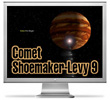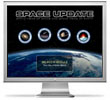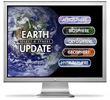
The evolution of SPACE UPDATE INC began in 1994 in the Space Physics Department (now the Rice Space Institute) at Rice University, when the Shoemaker-Levy 9 comet was poised to impact Jupiter. It was an exciting astronomical event that captured everyone's interest, but the internet was not yet widespread, and the general public had no access to the daily and hourly updates of images and science. We saw an opportunity to use new multimedia software tools, and our close relationship with the Houston Museum of Natural Science, to create a kiosk computer for the museum lobby displaying the latest results from observers around the world. With funding from the NASA "Public Use of the Internet" program (that also funded Google),that kiosk was the first of our museum software suite. Its easy-to-use interface along with daily manual updates made it a success. So successful in fact, that it became apparent that there was a market for well-made, topical, interactive software that could teach Earth and space science to the public. That wasn't our first outreach grant, though... we have had funded outreach programs going back to the NSF-funded "Teacher Research Program in 1988-1990".
Early products
In July of 1995, we debuted three software kiosks for display at HMNS: Earth Today, Space Weather, and Houston Today.
Earth Today: highlighting Earth resources and Earth weather. Weather maps and satellite weather images are updated hourly. Hurricane tracking charts are updated several times daily in hurricane season. Other imagery, such as bioactivity maps and sea temperature maps, are updated as available.
Space Weather: real-time predictions of space weather from various online sources; images of the sun from the NASA, auroral forecasts from the University of Alaska, and other real-time information on the hazards of space. (Note: an updated version of this software is still available for free download and also as part of Space Update)
Houston Today: highlighted the Houston area, showing weather graphs and maps from the "WeatherNet2" school-based system of local AWS weather stations (affilliated with KPRC-TV), one station being located at HMNS.

Soon after, we completed the first version of Space Update, a software kiosk combining sections on Astronomy, the Sky Tonight, the Solar System, Space Weather, and Space Events (no longer included). All of these early software products were updated throughout the day by uploading new images from our servers to the kiosk machines directly over the internet. It was a sensible approach that enabled us to control content and keep the kiosks updated and "safe" for use even while connected to the internet.
At this time the project took the name THE PUBLIC CONNECTION , sometimes internally referred to as simply CONNECTED, and we adopted a tagline that summarized the approach we planned to bring to our products: Earth Views Of Space and Space Views Of Earth. This tagline aptly describes how NASA and university scientists look out towards space with Earth based missions and also in towards the Earth environment using satellite technology.
Public Outreach
At this time NASA was in Phase 1 of a new initiative to focus on our own planet called EOS (Earth Observing System), a keystone of the MTPE (Mission To Planet Earth) Division, now known as ESE (Earth Science Enterprise). This endeavor has three main components: a series of Earth-observing satellites, an advanced data system, and teams of scientists who study the data. This also included funding for public outreach projects to help bring these science results to the public. Key areas of study include clouds; water and energy cycles; oceans; chemistry of the atmosphere; land surface; water and ecosystem processes; glaciers and polar ice sheets; and the solid Earth. We called our new project MUSEUMS TEACHING PLANET EARTH , so now our company promoting planetarium shows and equipment is MTPE, Inc.

Supported by NASA public outreach grants, in 1998 we debuted the 1.0 release of Earth Update, a suite of stand-alone software applications focusing on these five spheres of Earth science, Atmosphere, Biosphere, Cryosphere, Geosphere and Hydrosphere. Earth Update again used "push" technology to keep installation current with "today's data".
Over the next several years we updated our core software products (Space Update and Earth Update) and developed software games and activities to expand our growing list of educational software products. Our software CDs are now being used in schools and museums around the country, and have even flown on the Space Shuttle.
Planetarium Shows
Early in this decade, funding began for our new IMMERSIVE EARTH project (part of the NASA REASoN CAN) an outgrowth of MTPE - creating immersive show experiences for the public to learn about Earth and space science. We teamed once again with HMNS to produce "FORCE FIVE", the first of what has now evolved into a growing collection of full-dome digital planetarium shows. Our science knowledge and committment to public education and outreach, and HMNS's artists and planetarium experts, have fostered a partnership that continues to create fresh, innovative content in the fast-growing field of full-dome planetarium shows. We also continue to create software kiosk products to accompany these new shows, adding to the richness of the user experience. With this change in project focus, a new business e-Planetarium was created, formed as a way to market shows, software, and planetarium technology created by the Immersive Earth project and its partners.
Discovery Dome
In 2002, we created one of our most exciting projects to date - development and distribution of our "Discovery Dome" portable planetarium dome systems. Based on an original idea of Carolyn Sumners and Tony Butterfield of the Houston Museum of Natural Science, and developed with our NASA REASoN funding and many partners, these portable domes set-up and pack-away in minutes, and require only a laptop and projector, and run beautifully with our MediaShow display software. Our first public display was in 2003, and our first system sale was in 2005. Where before you had to visit a planetarium to experience the wonder of a full-dome immersive digital show...now the planetarium can come to you - a field trip without the bus ™ ! In the process, we updated Force 5 and created three more planetarium shows: Earth's Wild Ride, Dinosaur Prophecy, and Impact Earth. We have now also updated Force 5, and updated "Impact Earth" to be "Impact". Now with more than 200 systems in the field, we continue to expand our network, providing software and shows from many distributors.
Spinning Off
In 2013, Rice University transferred the Intellectual property of all the Rice-developed software and shows to our distribution company, MTPE, Inc. From now on, all support of our outreach efforts must come from sales of systems, shows and software. Our mission is to bring these items to the public at the least possible price consistent with being able to continually improve our products.
Contact us with questions or comments about Space Update Inc